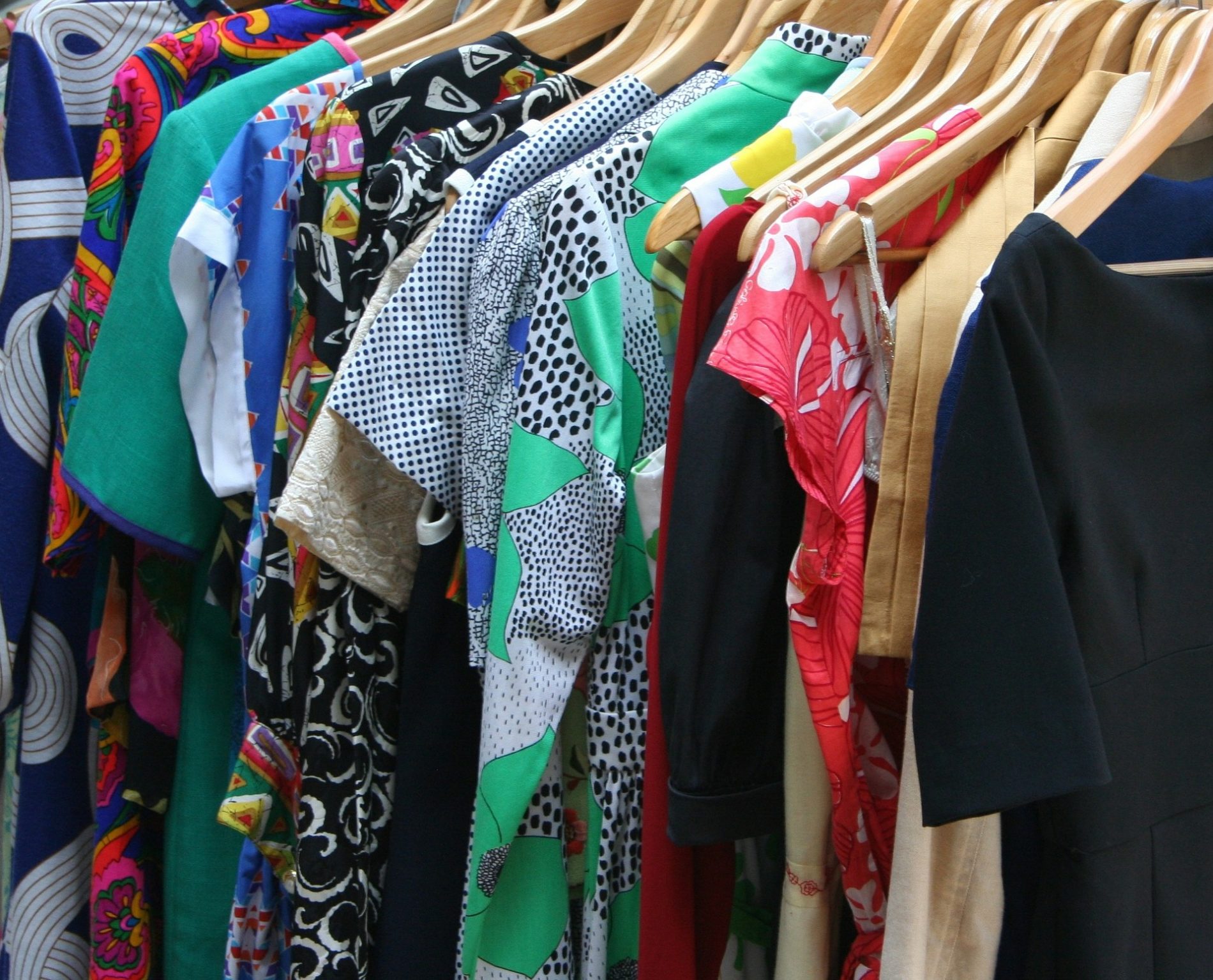Fast fashion brands use chemical additives to improve the functionality of their products. Unfortunately, the health of the wearer is the cost of this functionality.
The Health Effects of Wearing Fast Fashion
A study on the chemical penetration from textiles to skin by The National Center for Biotechnology Information indicates “that benzothiazole can be released from textile materials, penetrate through the skin, and further enter the human body. This will possibly also apply to other chemical contaminants in textiles, and the results of this study indicate that the presence of these textile contaminants entails potential health risks.’ Such health risks include endocrine disruption.

In the Photo: T-shirts on a rack. Contaminants in textiles pose health risks.
According to The Hormone Health Network, “EDCs [Endocrine Disrupting Chemicals] can also enter the body through the skin. […] Some consumer products contain EDCs or are packaged in containers which can leach EDCs, such as household chemicals, fabrics treated with flame retardants […]’ Further evidence of the endocrine disrupting potential of fast fashion fabrics is provided by Deidre Hoguet, Director of Sustainability and Material Exploration at Designtex. She wrote the following for The Guardian, informing us on antimicrobials. ’While purportedly limiting mould, mildew and pathogen growth on treated fabrics, their widespread use is thought to have contributed to the spike in antibiotic resistance and to endocrine disruption in humans.’ Within the same article for the Guardian, flame retardants are also mentioned as ‘they do not improve overall fire safety. They do, however, jeopardise human health: blood levels of widely used flame retardants are found in virtually all US citizens, and young children in the US now have some of the highest levels of flame retardants in their blood worldwide.’

In the Photo: Children are most at risk from these chemicals
So what are the effects of Endocrine Disrupting Chemicals on our bodies? The Hormone Health Network goes on to list these in their above mentioned article. According to them, EDCs affect our ‘response to psychological stress’, causing ‘neurological and behavioural changes’ and ‘reduced ability to handle stress’; metabolism in relation to obesity, type 2 diabetes and thyroid function; reproductive health, ‘by mimicking or blocking the effects of male and female sex hormones’; risk of getting cancer, as ‘exposure to oestrogen or androgen mimicking EDCs can promote breast and prostate cancer growth and/or interfere with hormonal cancer therapy’. Finally, EDCs affect growth and development, causing low-birth weight due to high exposure to EDCs during pregnancy, altered development, disrupted sexual development and weakened immune system.

In the photo: we absorb the chemicals in clothing through our skin
That last sentence leads to some good news and some bad news again by The Hormone Health Network. ‘Generally, chronic high exposures pose the highest risk, however, a developing fetus or infant is more vulnerable to lower exposures.’ Therefore, wearing sustainable fashion brands, which produce cleaner clothes, is better for adults in order to reduce exposure to EDCs, and it is important for children. More evidence of this is what Chih Ann Lee wrote for the Guardian – ‘Research published by Greenpeace found that some of the chemicals widely used in the textile industry are toxic to reproductive development in mammals or interfere with the hormone system. And children may be more sensitive to the effects of these hazardous chemicals than adults.’ According to Katherine Martinko for TreeHugger, ‘The effect that these chemicals can have on wearers, particularly children, is serious.’ Furthermore, the above mentioned research by Greenpeace about chemicals which affect children’s health, how they affect it and where they are found, states the following. ‘Studies have shown that alkylphenols, found in a range of products such as leather and textile finishers and in some detergents, contaminate children before and after birth.
In conclusion, the health effects of wearing fast fashion are that it contributes to the amount of exposure to endocrine disrupting chemicals which can lead to very unpleasant health issues, especially in children.

In the photo: Switching from high street brands to sustainable brands reduces exposure to harmful chemicals.
Why aren’t we worried about chemicals in textiles?
Now that we know some of the ways in which wearing fast fashion can affect our health, are we any more worried about it? I, personally, would certainly prefer a sustainable, chemical-free wardrobe but still find it hard to feel threatened by my clothes.
One reason for this might be that, at this point in time, it’s inconvenient for us to worry about it. What about the so called ‘shopping therapy’? Online shopping isn’t quite the same as strolling through high-street stores which are hardly ever sustainable fashion ones. What about all the clothes we already have? Who has the time and money to get a completely new toxin-free wardrobe? And will I really have to resist the temptation, from now on, to buy this awesome-looking and cheap garment I see on a fast fashion store’s display window? The worry, which wearing fast fashion can potentially cause, can certainly be less strong than the pleasure experienced from shopping. The dopamine which fires when we buy a new garment can often be enough to burn out the tiny bit of cortisol caused by the thought “wearing this will increase my exposure to harmful chemicals”. Not to even mention being worried about the environment at that very moment.

In the photo: Shopping for clothes.
Another reason might be that it simply isn’t a wide known fact yet that chemicals, such as EDCs, from the clothes we wear enter our bodies through our skin. This post from Forbes written by Kristie Wang for Ashoka Changemakers and Fabric of Change provides the fact that ‘most people don’t have any idea that their clothing is often coated with chemicals that may have a significant impact on human health and the environment.’ Not that many people are talking about the health effects of wearing toxic clothes and for some reason this makes it seem less scary; like it’s not a big deal. This could be due to a lack of information. According to The Hormone Health Network, ‘Although evidence linking EDCs to adverse health outcomes continues to grow, the cause-and-effect relationship is not yet fully understood.’

In the photo: A woman shops in the high street. Big Fashion brands need to change their behaviours.
It could also be that, maybe, the sustainable fashion market isn’t big enough yet in order for consumers to be bombarded with marketing messages about their health in relation to their clothes, similarly to how the organic food market blew up. Maybe, because fast fashion brands aren’t fast enough in cleaning up their act and adapting to what the planet calls for, this sustainable fashion marketing message isn’t taking over the consumers’ minds and conversation. However, the evidence above shows that following this marketing message is in their interest. It’s in their interest right now and always, before and after sustainable fashion takes over the high-street and our health suddenly becomes important to all the big fashion brands who. hopefully, will catch up and stop using harmful chemicals.
Here are top sustainable fashion brands listed according to the type of clothes they offer.
Here is a list of great children’s sustainable clothing brands.










